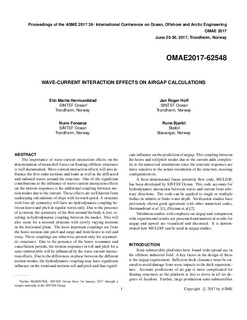| dc.contributor.author | Hermundstad, Elin Marita | |
| dc.contributor.author | Hoff, Jan Roger | |
| dc.contributor.author | Fonseca, Nuno | |
| dc.contributor.author | Bjørkli, Rune | |
| dc.date.accessioned | 2017-10-12T06:50:42Z | |
| dc.date.available | 2017-10-12T06:50:42Z | |
| dc.date.created | 2017-10-11T09:57:08Z | |
| dc.date.issued | 2017-06-25 | |
| dc.identifier.citation | ASME 2017 36th International Conference on Ocean, Offshore and Arctic Engineering - Volume 1: Offshore Technology | nb_NO |
| dc.identifier.isbn | 978-0-7918-5763-2 | |
| dc.identifier.uri | http://hdl.handle.net/11250/2459786 | |
| dc.description.abstract | The importance of wave-current interaction effects on the determination of mean drift forces on floating offshore structures is well documented. Wave-current interaction effects will also influence the first-order motions and loads as well as the diffracted and radiated waves around the structure. One of the significant contributions to the influence of wave-current interaction effects on the motion responses is the additional coupling between motion modes due to the current. These effects are well known from seakeeping calculations of ships with forward speed. A structure with fore-aft symmetry will have no hydrodynamic coupling between heave and pitch in regular waves only. Due to the presence of a current, the symmetry of the flow around the body is lost, resulting in hydrodynamic coupling between the modes. This will also occur for a moored structure with slowly varying motions in the horizontal plane. The most important couplings are from the heave motion into pitch and surge and from heave to roll and sway. These couplings are otherwise present only for asymmetric structures. Due to the presence of the heave resonance and cancellation periods, the motion responses in roll and pitch for a semi-submersible will be influenced by the wave-current interaction effects. Due to the differences in phase between the different motion modes, the hydrodynamic coupling may have significant influence on the rotational motions roll and pitch and thus significant influence on the prediction of airgap. This coupling between the heave and roll/pitch modes due to the current adds complexity to the numerical simulations since the structure responses are more sensitive to the actual orientation of the structure, mooring configuration etc. A three-dimensional linear potential flow code, MULDIF, has been developed by SINTEF Ocean. This code accounts for hydrodynamic interaction between waves and current from arbitrary directions. The code can be applied to single or multiple bodies in infinite or finite water depth. Verification studies have previously shown good agreement with other numerical codes, Hermundstad et.al. [1], Zhiyuan et.al [2]. Validation studies with emphasis on airgap and comparison with experimental results are presented and numerical results for airgap and upwell are visualized and discussed. It is demonstrated how MULDIF can be used in airgap studies. | nb_NO |
| dc.language.iso | eng | nb_NO |
| dc.relation.ispartof | ASME 2017 36th International Conference on Ocean, Offshore and Arctic Engineering - Volume 1: Offshore Technology | |
| dc.relation.ispartofseries | ASME Proceedings | Offshore Technology;OMAE2017-62548 | |
| dc.subject | Waves | nb_NO |
| dc.title | Wave-Current Interaction Effects on Airgap Calculations | nb_NO |
| dc.type | Chapter | nb_NO |
| dc.description.version | acceptedVersion | nb_NO |
| dc.rights.holder | Copyright © 2017 by ASME | nb_NO |
| dc.identifier.doi | 10.1115/OMAE2017-62548 | |
| dc.identifier.cristin | 1503734 | |
| cristin.unitcode | 7566,9,0,0 | |
| cristin.unitname | Hydrodynamikk | |
| cristin.ispublished | true | |
| cristin.fulltext | postprint | |
| cristin.qualitycode | 1 | |
